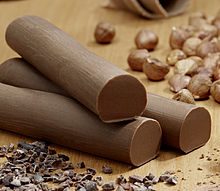
Summary
Gianduia or gianduja (Italian: [dʒanˈduːja];[1] Piedmontese: giandoja, Piedmontese: [dʒaŋˈdʊja]) is a homogeneous blend of chocolate with 30% hazelnut paste, invented in Turin during Napoleon's regency (1796–1814). It can be consumed in the form of bars or as a filling for chocolates.
 Gianduja bars | |
| Type | Chocolate |
|---|---|
| Place of origin | Italy |
| Region or state | Turin, Piedmont |
| Main ingredients | Chocolate paste, hazelnut paste |
| |
Gianduja is chocolate stretched with hazelnut butter. Similarly to standard chocolate, it is made in both plain and milk versions. It may also contain other nuts, such as almond.[2] As a bar, gianduja resembles normal chocolate, except for the fact that it is significantly softer due to the presence of hazelnut oil,[3] which is liquid at room temperature unlike cocoa butter. However, like conventional chocolate, gianduja is usually tempered.[4]
Chocolate hazelnut spreads are also notably inspired from gianduja. They tend to use, however, other ingredients, typically cocoa powder and vegetable oils rather than cocoa butter-based chocolate.
History edit
The Continental System, imposed by Napoleon in 1806, prevented British goods from entering European ports under French control, putting a strain on cocoa supplies.[5] A chocolatier in Turin named Michele Prochet extended the little chocolate he had by mixing it with hazelnuts from the Langhe hills south of Turin.[6] It is unclear when gianduja bars were made for the first time. However, Kohler is generally credited for the addition of (whole) hazelnuts to chocolate bars in 1830.[7] It is also known that, in 1852, Turin-based chocolate manufacturer Caffarel invented gianduiotto, which is a small ingot-shaped gianduja.[8]
It takes its name from Gianduja, a Carnival and marionette character who represents the archetypal Piedmontese, natives of the Italian region where hazelnut confectionery is common.
See also edit
References edit
- ^ "Focus on Gianduia, Part 1.5: Orthography and Pronunciation – DallasFood". dallasfood.org.
- ^ Beckett, Steve T. (2011). "Gianduja chocolate". Industrial Chocolate Manufacture and Use. John Wiley & Sons. ISBN 9781444357554.
- ^ Medrich, Alice (2015). Pure Dessert: True Flavors, Inspiring Ingredients, and Simple Recipes. Artisan Books. p. 157. ISBN 9781579656850.
gianduja resembles a bar of chocolate. It is softer on the tooth than a plain chocolate bar (because of the oil from the hazelnuts)
- ^ Laiskonis, Michael (16 March 2021). "Going Nuts for Gianduja". Institute of Culinary Education. Retrieved 18 March 2024.
- ^ Elena Kostioukovitch (2009) Why Italians Love to Talk About Food p.95, Farrar, Straus and Giroux, ISBN 978-0374289942
- ^ ""Turin's chocolatiers" (Feb 2013) Gourmet Traveller Magazine". Archived from the original on 2020-04-11. Retrieved 2014-05-26.
- ^ Hermé, Pierre (2019). Le Larousse du chocolat. Editions Larousse. p. 44. ISBN 9782035981820.
Les noisettes furent les premiers fruits à être ajoutés dans le chocolat solide, une innovation suisse due à Kohler en 1830.
[Hazelnuts were the first fruits to be added to solid chocolate, a Swiss innovation due to Kohler in 1830.] - ^ "Caffarel – Finest Chocolate and the Best Hazelnuts". Caffarel.
- ^ The History of Nutella Archived 2015-09-12 at the Wayback Machine


